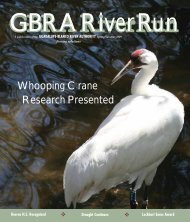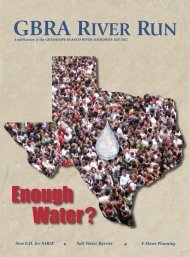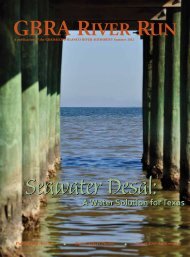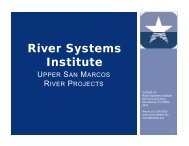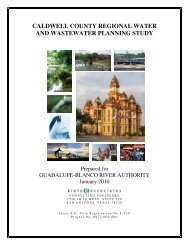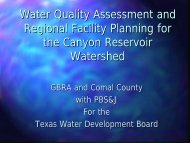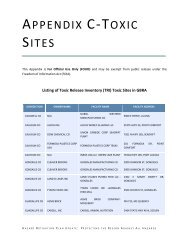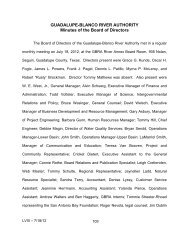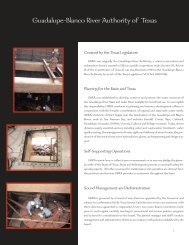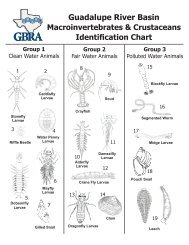Spring 2010 - Guadalupe-Blanco River Authority
Spring 2010 - Guadalupe-Blanco River Authority
Spring 2010 - Guadalupe-Blanco River Authority
Create successful ePaper yourself
Turn your PDF publications into a flip-book with our unique Google optimized e-Paper software.
GBRA <strong>River</strong> Run<br />
A publication of the GUADALUPE-BLANCO RIVER AUTHORITY <strong>Spring</strong> <strong>2010</strong><br />
Is This Where<br />
We’re Heading<br />
SMWTP Celebrates 10 Years Watershed Protection in Kyle Quenched Drought
From the GM<br />
When the Feds Come Marching In …<br />
By now, many of you have heard about the lawsuit filed in federal court by The Aransas Project (TAP) against the Texas<br />
Commission on Environmental Quality (TCEQ), alleging a “take” on the endangered whooping crane during last year’s drought<br />
and requesting federal oversight to possibly reallocate water rights on the <strong>Guadalupe</strong> and San Antonio rivers. The <strong>Guadalupe</strong>-<br />
<strong>Blanco</strong> <strong>River</strong> <strong>Authority</strong> (GBRA), therefore, is inextricably tied to this lawsuit against the TCEQ. TAP is attempting to turn upside<br />
down the entire system of water rights allocation in the state of Texas and have the federal government take it over.<br />
Clearly, the GBRA has led the way in developing important new information about the whooping<br />
crane and its habitat. GBRA, along with the San Antonio <strong>River</strong> <strong>Authority</strong> and other partners, funded the<br />
research that investigated the diet, behavior and habitat of whooping cranes in the Aransas National<br />
Wildlife Refuge on San Antonio Bay.<br />
This seven-year study — conducted by a team of renowned Texas A&M University researchers led<br />
by Dr. R. Douglas Slack — evaluated the relationship between freshwater inflows feeding San Antonio<br />
Bay and the health of its endangered whooping crane population. The researchers’ conclusions do not<br />
support the draconian allegations made by TAP.<br />
If successful, TAP’s lawsuit would mean the stripping of water from municipal, agricultural, and<br />
industrial water right holders along the <strong>Guadalupe</strong> and San Antonio river basins and reassigning it to the<br />
causes requested by TAP. That means the water rights for Kerrville, Boerne, New Braunfels, San Marcos,<br />
Seguin, Lockhart, Luling, Gonzales, Cuero, Victoria, Port Lavaca, and Refugio, as well as for companies<br />
like Dow and Dupont could be reduced or cancelled. Lower <strong>Guadalupe</strong> Basin communities’ efforts to<br />
achieve additional economic development and new jobs could be hamstrung. Farmers and ranchers also<br />
could have water rights curtailed or cancelled.<br />
TAP’s lawsuit also could disrupt two processes put into place by the Texas Legislature — the Edwards<br />
Aquifer Recovery Implementation Program (EARIP) and the Environmental Flows (E-flows) process.<br />
The EARIP is a process designed to achieve consensus on how the Edwards Aquifer is to be managed<br />
for the mutual benefit of all who depend on it. This scientific process has been underway for more than<br />
a year and is required to be completed by 2012.<br />
The E-flows process also is designed to achieve consensus on how the instream flows and bay and<br />
estuary freshwater flows are to be provided for the health and welfare of the rivers, bays and estuaries.<br />
Although the lawsuit targets the <strong>Guadalupe</strong> <strong>River</strong>, it could have the same impact on other river systems in Texas that currently<br />
has or is under consideration to have endangered species listed in or near its waterways. In other words, the suit may affect the<br />
great majority of the people living in this state and the economy that sustains them.<br />
Is that what Texans really want A judge of the federal court in Corpus Christi has indicated that we very well may be<br />
addressing that issue before her in March 2011.<br />
Whooping cranes exist in nature, and nature’s conditions can be both beneficial and harsh, as witnessed by the recent<br />
22-month long drought in the Southwest. Even so, the U.S. Fish and Wildlife Service, GBRA, and other interested organizations<br />
and individuals will continue to work so that conditions in their wintering habitat along San Antonio Bay will enable these<br />
beautiful creatures to survive and prosper.<br />
But one has to ask, “Where is the same level of concern for the people of Texas”<br />
W. E. “Bill” West, Jr.<br />
General Manager
<strong>Guadalupe</strong>-<strong>Blanco</strong> <strong>River</strong> <strong>Authority</strong><br />
Board of Directors<br />
T. L. Walker, Chair (Comal County)<br />
Grace L. Kunde, Vice Chair (<strong>Guadalupe</strong> County)<br />
Oscar Fogle, Secretary-Treasurer (Caldwell County)<br />
Clifton L. Thomas, Jr., (Victoria County)<br />
Arlene Marshall (Calhoun County)<br />
Unfilled (Dewitt County)<br />
Myrna McLeroy, (Gonzales County)<br />
Jim Powers (Hays County)<br />
Michael D. Schultz (Kendall County)<br />
Frank J. Pagel (Refugio County)<br />
contents<br />
<strong>River</strong> Run <strong>Spring</strong> <strong>2010</strong><br />
Executive Management<br />
William E. “Bill” West, Jr., President and General Manager<br />
Alvin Schuerg, Executive Manager of Finance and Administration<br />
Todd Votteler, Executive Manager of Intergovernmental Relations<br />
and Policy<br />
David Welsch, Executive Manager of Business Development and<br />
Resource Management<br />
James Murphy, Executive Manager of Water Resources and<br />
Utility Operations<br />
Bruce Wasinger, General Counsel<br />
GBRA <strong>River</strong> Run<br />
<strong>Spring</strong> <strong>2010</strong><br />
Editor<br />
LaMarriol Smith, Manager of Communications and Education<br />
Art Direction and Design<br />
Connie Rothe, Board Relations<br />
Editorial<br />
Tammy Beutnagel, Public Communications Assistant<br />
Cinde Thomas-Jimenez, Education Coordinator<br />
Joel Williams, Dublin and Associates Staff<br />
LaMarriol Smith<br />
GBRA <strong>River</strong> Run is published by the Office of Communications and<br />
Education of the <strong>Guadalupe</strong>-<strong>Blanco</strong> <strong>River</strong> <strong>Authority</strong>. The Office of<br />
Communications and Education retains the right to determine the<br />
editorial content and presentation of information contained herein.<br />
Articles or opinion written by guest writers do not necessarily reflect<br />
official views or policy of the GBRA or its Board of Directors.<br />
Contact GBRA <strong>River</strong> Run:<br />
Office of Communications and Education<br />
<strong>Guadalupe</strong>-<strong>Blanco</strong> <strong>River</strong> <strong>Authority</strong><br />
933 E. Court<br />
Seguin, TX 78155<br />
Editor: 830.379.5822<br />
Email: editor@gbra.org<br />
The <strong>Guadalupe</strong>-<strong>Blanco</strong> <strong>River</strong> <strong>Authority</strong> is an Equal Opportunity Employer.<br />
It is the policy of GBRA not to discriminate against any employee or<br />
applicant for employment because of race, age, color, religion, sex,<br />
national origin, political affiliation, veteran status or disability.<br />
Features<br />
ESA Lawsuit Opens Door to Federal<br />
Control of Texas Water.....................8<br />
Quenched Drought Leads to Promising<br />
Water Recreation Season...............12<br />
Departments<br />
Field and Office................................ 2<br />
The Trust.......................................... 7<br />
Inside GBRA................................... 13<br />
Mark Your Calendar............ back page<br />
© 2009 <strong>Guadalupe</strong>-<strong>Blanco</strong> <strong>River</strong> <strong>Authority</strong><br />
w w w . g b r a . o r g<br />
Front cover illustration: by M Square Design<br />
Back cover photo: by LaMarriol Smith<br />
1
FIELD & OFFICE<br />
Kyle Cleanup and Watershed Protection<br />
More than 300 Kyle area volunteers devoted Saturday morning,<br />
February 27th to help cleanup their local environment in the Kyle<br />
Parks and Plum Creek Watershed Clean-Up. Partners for the event<br />
were the City of Kyle Parks and Recreation Department, the <strong>Guadalupe</strong>-<br />
<strong>Blanco</strong> <strong>River</strong> <strong>Authority</strong>, the Plum Creek Watershed Partnership, and Hays<br />
CISD, notably Lehman High and Fuentes Elementary.<br />
Participants removed more than 1,740 pounds of recyclable materials<br />
and 1,720 pounds of trash from around Plum Creek in Steeplechase Park<br />
and Lake Kyle in the Plum Creek Preserve and Nature Trail. The Plum<br />
Creek Preserve and Nature Trail is property that was recently acquired by<br />
the Kyle Parks and Recreation Department through a grant from Texas<br />
Parks and Wildlife. The property will open to the public later in <strong>2010</strong>. In<br />
all, more than 3.5 miles city property alongside Plum Creek was tackled.<br />
As a predecessor for the event, existing dog waste in Steeplechase<br />
Park was addressed to provide a visual demonstration of the potential<br />
for contamination to Plum Creek with bacteria. On February 26th,<br />
approximately 100 fourth grade students from Fuentes Elementary spent<br />
their science class time in Steeplechase Park, marking pet waste for<br />
cleanup the next day. The Kyle Parks and Recreation Department noted<br />
that after 550 dog droppings were marked in 2009, only 128 were found<br />
in <strong>2010</strong>. The city has installed pet waste stations in the park with bags for<br />
easy clean-up, and it appears as though residents are getting the message.<br />
Kyle is located at the headwaters of the Plum Creek Watershed. All rain,<br />
irrigation, and runoff within city limits drains into small local streams,<br />
including Plum Creek. Because this water forms the beginnings of Plum<br />
Creek, the city plays an important role in water quality downstream as the<br />
creek meanders 52 miles past Lockhart and Luling before finally flowing<br />
into the San Marcos <strong>River</strong>.<br />
To find out more about watershed protection efforts in the Plum Creek<br />
Watershed, visit http://plumcreek.tamu.edu/.<br />
Park cleanup volunteers<br />
Photos by Jim Cullen<br />
2
New Boat Ramp Opens at Canyon Lake<br />
Officials with area water entities formed<br />
a beneficial partnership and took the<br />
opportunity of low water conditions on<br />
Canyon Lake to make major improvements to<br />
one of the existing Comal County boat ramps.<br />
This improved facility, Ramp #2 located in the<br />
Village West Subdivision, opened at Canyon Lake<br />
in late December.<br />
Staff from the Water Oriented Recreation<br />
District (WORD),<br />
<strong>Guadalupe</strong>-<strong>Blanco</strong> <strong>River</strong><br />
<strong>Authority</strong> (GBRA), Comal<br />
County, and the United<br />
States Army Corps of<br />
Engineers (Corps) got<br />
together to discuss the<br />
condition of County boat<br />
ramps at Canyon Lake.<br />
Boat Ramp #2, also<br />
known as Village West<br />
and located off of Colleen<br />
Drive, was identified as<br />
steep and badly in need<br />
of repairs. It was deemed<br />
one of the few ramp<br />
areas capable of being<br />
run deeper into the lake,<br />
yet previously provided poor access during low<br />
reservoir conditions. The ramp now provides<br />
better access for the south side of the lake.<br />
A partnership was formed, with WORD and<br />
GBRA each contributing $30,000 towards the<br />
project with Comal County handling engineering,<br />
construction, and project oversight.<br />
The Corps secured all necessary permissions<br />
for the work to be done. The old ramp was<br />
demolished, and a new one built just next to<br />
it. A circular drive was also added for ease of<br />
use getting on and off the ramp. By conducting<br />
the work while the reservoir was low, the<br />
construction staff was able to take advantage<br />
of the record low lake levels to extend the ramp<br />
almost 6 feet deeper into the water than the old<br />
one, making it much more versatile and keeping<br />
it open much longer during drought.<br />
Photos by David Welsch<br />
TPWD Funds Boat Ramp Projects<br />
in the Basin<br />
Two areas in the <strong>Guadalupe</strong>-<strong>Blanco</strong> <strong>River</strong><br />
<strong>Authority</strong>’s basin recently benefitted from<br />
the Texas Parks and Wildlife Commission’s<br />
approval of more than $2.5 million in grants to<br />
pay for boat ramp construction or repair projects<br />
across the state.<br />
GBRA was awarded $75,000 for renovation of<br />
a boat ramp at Lake Wood, plus a walkway and<br />
courtesy dock to improve access for people with<br />
disabilities, new bulkhead, lighting and signage.<br />
On the lower end of the basin, Calhoun<br />
County was awarded $126,000 to build a rock<br />
jetty to protect an existing public boat ramp<br />
on Magnolia Beach and improve lighting and<br />
signage. The boat ramp affords public access to<br />
Lavaca Bay. The jetty will project against silting<br />
and wave damage and make it safer to launch or<br />
land at the ramp.<br />
The funding was made possible by the<br />
State Boating Access Program authorized by<br />
the 64th Legislature in 1975. The program<br />
provides funding for the purchase, construction,<br />
renovation and maintenance of boat ramps,<br />
access roads and other related projects aimed<br />
at improving the recreational boater’s access<br />
to public waters. The money for the program<br />
comes back to the states from the federal<br />
recreational boating gasoline tax and an excise<br />
tax on fishing tackle collected under the Federal<br />
Aid to Sport Fish Recreation Act.<br />
3
out 50 acres of control invasive waterhyacinths were<br />
killed when <strong>Guadalupe</strong>-<strong>Blanco</strong> <strong>River</strong> <strong>Authority</strong> work<br />
crews lowered the levels of Lake Gonzales (H-4) and<br />
Lake Wood (H-5) approximately 1.5 feet during a hard freeze<br />
in January. At the time, the National Weather Service forecast<br />
a hard freeze across much of the State, including lows<br />
between 23 and 18 degrees in Gonzales County Jan. 7-10.<br />
GBRA officials employed this natural and less expensive<br />
method than chemical treatments to kill off some of the<br />
plants by allowing nature to freeze the plants’ root systems.<br />
“Because water tends to protect the root ball of the plants from<br />
freezing, lowering the lake levels exposes the root systems to<br />
the freeze, killing the hyacinth,” explained Debbie<br />
Magin, GBRA’s director of Water Quality.<br />
GBRA staff observed that the freeze<br />
covered the whole park slough<br />
at Lake Wood Park and boat<br />
ramp area with ice about<br />
3/16 of an inch thick from<br />
the entrance pipes to the<br />
end of the slough for at<br />
least two nights. On<br />
the third night, the<br />
slough surface froze<br />
from the bridge<br />
to the end and<br />
along the banks<br />
to the entrance<br />
pipes. Most of<br />
the hyacinths at<br />
the end of the<br />
slough were out<br />
of the water and in<br />
the mud during the<br />
freeze. In terms of<br />
surface acreage, staff<br />
estimated 40-50 acres<br />
of the hyacinths<br />
were destroyed with<br />
the freeze.<br />
Photos by Steve Taylor<br />
4<br />
Photo by Mark Heneke
Victoria Regional WWTP Employees<br />
Give 38 Years of Service<br />
by Tammy Beutnagel<br />
<strong>Guadalupe</strong>-<strong>Blanco</strong> <strong>River</strong> <strong>Authority</strong><br />
officials honored the organization’s<br />
Victoria Regional Wastewater<br />
Reclamation System employees at a<br />
banquet dinner on February 18, <strong>2010</strong> in<br />
Victoria. With the exception of employees<br />
eligible for retirement this year, the majority<br />
of GBRA employees will transition to the<br />
City of Victoria.<br />
The wastewater system contract will<br />
transition to the City of Victoria at the end<br />
of this year — marking the end of a<br />
contract executed in 1972 between<br />
GBRA and the city.<br />
This partnership created a<br />
renovation of the original Willow<br />
Street plant and a new and expanded<br />
plant on Loop 175. The Willow<br />
Street plant treats 2.5 million gallons<br />
of wastewater per day, while the<br />
newer Victoria Regional Wastewater<br />
Reclamation<br />
System can treat<br />
up to 9.6 million<br />
gpd. Both plants<br />
have provided<br />
wastewater<br />
treatment<br />
service in an<br />
environmentally-responsible manner with an<br />
on-site laboratory to conduct daily sample<br />
testing to ensure treated product meets<br />
state and federal guidelines.<br />
Experienced and highly trained GBRA<br />
employees operated the plants. Prior to<br />
this year’s transition, 10 of the 17 GBRA<br />
employees had earned “A” licensed<br />
wastewater certifications.<br />
“The key to our success over the last<br />
38 years has always been our employees,<br />
both past and present. This division would<br />
not have survived as long as it has without<br />
the dedication, loyalty and hard work of<br />
its employees,” said Bryan Serold, GBRA<br />
operations manager for the Lower Basin.<br />
“I also witnessed a unity and sense of<br />
family first-hand during the 1998 flood<br />
recovery efforts when the staff pulled<br />
together to overcome what seemed to<br />
be insurmountable odds in restoring the<br />
flooded regional plant,” said Serold.<br />
“We are so very thankful for each<br />
and every one of these employees’<br />
and their years of service. Each<br />
person was like a family member<br />
in the GBRA family and they will<br />
always be remembered,” said Bill<br />
West, GBRA general manager.<br />
“We know those who transition<br />
to city employment will continue<br />
doing a great job<br />
with the City of<br />
Victoria,”<br />
he added.<br />
Fifteen of the 17<br />
Victoria employees<br />
are pictured.<br />
5<br />
Photos by Jim Wyatt
Officials Recognize 10 Years of Operations<br />
at the San Marcos Water Treatment Plant<br />
While 22 months of drought recently scorched the Central<br />
and South-Central Texas areas and despite some watering<br />
restrictions, one constant that San Marcos residents were able<br />
to rely on when they opened the tap was clean water treated at the San<br />
Marcos Water Treatment Plant (SMWTP.) This January marked the<br />
tenth anniversary of the start-up of the SMWTP and <strong>Guadalupe</strong>-<strong>Blanco</strong><br />
<strong>River</strong> <strong>Authority</strong> (GBRA) Regional Raw Water Delivery System’s service<br />
to citizens in the Hays County area.<br />
In January 2000, GBRA’s 30-inch diameter pipeline and the City of<br />
San Marcos’ 6 million-gallon-per-day (MGD) water treatment plant<br />
(WTP) were placed into operation. The City of San Marcos and GBRA<br />
have become equity partners in the pipeline and treatment plant when<br />
the City of San Marcos selected GBRA to operate the plant.<br />
“The City’s foresight in recognizing the need of such a facility, the<br />
citizens’ support of the project, and GBRA’s commitment to providing<br />
high quality operations and maintenance have led to one of the best<br />
water treatment plants in the State,” said Bill West, GBRA’s general<br />
manager. “This project is a model example of a regional water supply<br />
project that meets the needs of numerous entities,” added West.<br />
Since the plant opened in 2000, the Texas Commission on<br />
Environmental Quality (TCEQ) has awarded the SMWTP operators<br />
five consecutive Texas Optimization Program (TOP) Awards. The<br />
TOP Ops is awarded to selected plants in Texas that are producing<br />
the safest drinking water possible. This award is based on a<br />
voluntary, nonregulatory program designed to consistently improve<br />
the performance of existing surface water treatment plants without<br />
major capital improvements. The TOP Ops award also evaluates the<br />
operators’ success to meet all rigorous criteria for a comprehensive<br />
performance evaluation in a specific time period.<br />
On three different occasions TCEQ has chosen to use the SMWTP<br />
for new inspector training, advanced inspector training on Special<br />
Performance Evaluations, and for a TOP Ops training. According to<br />
Jack Schulze, member of TCEQ technical review and oversight team,<br />
SMWTP is one of the few treatment plants in Texas that has both<br />
internal and external sludge recirculation capability on its clarifier.<br />
This advanced equipment allows TCEQ to show inspectors how both<br />
technologies work and complement one another.<br />
Milestones of SMWTP:<br />
In January 2000, the GBRA 30-inch<br />
diameter pipeline and the City of<br />
San Marcos 6 MGD WTP were<br />
placed into operation. The City of<br />
San Marcos selected GBRA to<br />
operate the plant.<br />
The plant was expanded to 9MGD<br />
in 2004.<br />
In 2006 the original IH-35 pump<br />
station, pipeline, and 0.5 MG ground<br />
storage tank were completed.<br />
In 2007 the SMWTP was expanded<br />
from 9 MGD to 21 MGD.<br />
In 2008 the regional raw water pump<br />
stations #2 and #3, increasing the<br />
plant capacity from 16 MGD to 25<br />
MGD, were completed.<br />
Photo courtesy GBRA Archives<br />
6
THE TRUST<br />
<strong>Guadalupe</strong>-<strong>Blanco</strong> <strong>River</strong> Trust Secures<br />
6,200-Acre Conservation Easement<br />
M<br />
ore than 6,200 acres of property along the San<br />
Antonio <strong>River</strong> in Goliad County is being preserved<br />
through a conservation easement with the Fuller<br />
family and the <strong>Guadalupe</strong>-<strong>Blanco</strong> <strong>River</strong> Trust (GBR Trust). The<br />
easement, executed December 16, 2009, becomes the largest<br />
tract of property secured by the GBR Trust since its inception<br />
in 2001. A conservation easement is a legal agreement between a<br />
landowner and a conservation organization or government agency<br />
that permanently limits a property’s uses in order to protect the<br />
property’s conservation value.<br />
Dr. James Fuller, his wife Mary and family own the 6,201-acre<br />
tract that features seven miles of San Antonio <strong>River</strong> frontage<br />
and diverse topography. The Fullers plan to pass the land to their<br />
three sons who are actively involved with the management of<br />
the land. “We wanted to see this beautiful property preserved for<br />
7<br />
our three sons and ultimately for<br />
their families, rather than being<br />
fragmented and developed,” Dr.<br />
Fuller said.<br />
“All of us love the ranch, and<br />
our sons are environmentally<br />
conscious and concerned<br />
about keeping the property in<br />
tact – preserving it for future<br />
generations. This easement will<br />
help us do that,” Mary Fuller<br />
explained.<br />
The Fullers also participate in<br />
the Conservation Crop Rotation<br />
Program with Natural Resource<br />
Conservation Service (NRCS),<br />
which provides food, cover and<br />
water for livestock and wildlife,<br />
specifically quail.<br />
In addition to NRCS, the<br />
family also works with the United<br />
States Fish and Wildlife Service<br />
(USFWS) and the Texas Parks and<br />
Photo by James Fuller<br />
Wildlife Department (TPWD) to<br />
manage their land for wildlife, yet still manage an active ranch.<br />
They also practice wildlife management techniques, such as<br />
controlled burns.<br />
The Fuller’s homestead is situated at the highest point on the<br />
property, which allows a stunning view from the wrap-around<br />
front porch.<br />
As the Fullers began to acquire the land over the years, they<br />
worked hard to clean up the land of abandoned homes and other<br />
debris that past owners left behind.<br />
Over the years the family had considered entering into a<br />
conservation easement and recently decided it was time to move<br />
forward with the easement to protect the land from future<br />
development and to preserve it for future generations.
ESA Lawsuit Opens Doo<br />
of Texas Water<br />
by Joel Williams<br />
Is the federal government about to take<br />
over management of surface water<br />
in Texas<br />
A recent lawsuit filing and a petition, both<br />
initiated under the Endangered Species Act,<br />
could have the far-reaching impact of<br />
placing the state’s waterways under strict<br />
federal oversight.<br />
The lawsuit involves an endangered<br />
international icon, the whooping crane.<br />
The petition involves a lesser-known type of<br />
animal, dozens of species of mussel that live<br />
along various rivers in the state.<br />
The Whooping Crane Lawsuit<br />
In March, an organization called The<br />
Aransas Project (TAP) sued the Texas<br />
Commission on Environmental Quality (TCEQ).<br />
The suit, filed in U.S. District Court in Corpus<br />
Christi, alleges that state management of the<br />
<strong>Guadalupe</strong><br />
and San<br />
Antonio<br />
rivers has<br />
harmed the<br />
whooping<br />
cranes that<br />
winter at<br />
Aransas National Wildlife Refuge. It accuses<br />
the agency of violating the federal Endangered<br />
Species Act (ESA) by not allowing enough<br />
fresh water to reach the coastal marshes<br />
where 23 whooping cranes are said to have<br />
died in the winter of 2008-2009.<br />
“Obviously, if the lawsuit for the endangered<br />
whooping crane is successful in usurping water<br />
rights on the <strong>Guadalupe</strong> <strong>River</strong>, the same legal<br />
logic could be used on any other Texas river<br />
where there are endangered species.”<br />
Specifically, the TAP lawsuit alleges that<br />
the state agency has violated the “taking”<br />
provision in Section 9 of the federal ESA. It<br />
prohibits a “take,” any activity causing the<br />
death or harm to a listed species, or that<br />
destroys its habitat. If the federal court found<br />
that the state’s surface water management<br />
practices were resulting in whooping crane<br />
deaths, federal officials could assume<br />
control of water management in Texas.<br />
That could mean an end to the issuance of<br />
new water permits, the imposition of a<br />
whooping crane habitat<br />
conservation plan,<br />
reductions in<br />
the amount<br />
of water<br />
diverted and the timing<br />
of such diversions of existing surface water<br />
rights. Groundwater management could be<br />
affected as well because the Trinity, Edwards<br />
and Carrizo-Wilcox Aquifers contribute<br />
significantly to the baseflow of the<br />
<strong>Guadalupe</strong> <strong>River</strong>.<br />
The Aransas Project’s leadership includes<br />
members of the family that owns the D.M.<br />
O’Connor Ranches of Texas, with roots in<br />
Aransas County. Houston-based attorney<br />
Jim Blackburn, who<br />
represents TAP, also<br />
represented the<br />
O’Connor family in their<br />
attempt to block Exelon<br />
Corp. from obtaining a<br />
surface water supply that<br />
would make it possible<br />
for the company to build a nuclear power plant<br />
in the region. The site secured by Exelon for<br />
its plant would be located adjacent to property<br />
owned by the O’Connor family.<br />
“The harm that the Whooping Cranes have<br />
experienced is a direct result of TCEQ’s failed<br />
oversight of its water rights permit programs<br />
in the <strong>Guadalupe</strong> <strong>River</strong> Basin where too much<br />
water is being taken out of the <strong>Guadalupe</strong> and<br />
San Antonio rivers, especially during low-flow<br />
conditions,” TAP attorney Jim Blackburn said<br />
after filing the lawsuit. “The scientific evidence<br />
strongly indicates that, during lower flow<br />
8<br />
conditions, the full use of existing water rights<br />
in this basin — granted and overseen by TCEQ<br />
— will worsen the condition of the whooping<br />
cranes if fully utilized.”<br />
The Mussels Petition<br />
The petition that could bring Texas rivers<br />
under federal control involves an effort to have<br />
nine species of mussels living along various<br />
rivers in Texas listed as “endangered.”<br />
In December, the U.S. Fish and Wildlife<br />
Service (USFWS), which has jurisdiction to<br />
ensure compliance with ESA provisions, filed<br />
notice in the Federal Register, “To List Nine<br />
Species of Mussels from Texas as Threatened<br />
or Endangered with Critical Habitat.”
for Federal Control<br />
The<br />
proposed<br />
listing was in<br />
response to<br />
petitions filed by<br />
a conservation group<br />
called WildEarth Guardians. The mussels<br />
under consideration for listing as threatened<br />
or endangered, in Texas, according to the<br />
USFWS, include:<br />
Texas fatmucket<br />
(Lampsilis<br />
bracteata), Texas<br />
heelsplitter<br />
(Potamilus<br />
amphichaenus), Salina mucket (Potamilus<br />
“It gives the U.S. Fish and Wildlife<br />
Service a great deal of authority to have<br />
things changed in ways that benefit<br />
endangered species.”<br />
metnecktayi), Smooth pimpleback (Quadrula<br />
houstonensis), Texas pimpleback (Quadrula<br />
petrina), False spike (Quincuncina mitchelli),<br />
Mexican fawnsfoot (Truncilla cognata), and<br />
Texas fawnsfoot (Truncilla macrodon).<br />
“Based on our review, we find that the<br />
petitions present substantial scientific or<br />
commercial information indicating that<br />
listing these species may be warranted,” Fish<br />
and Wildlife Service officials indicate in the<br />
Federal Register filing.<br />
Together, the whooping crane and mussels<br />
cases could result in drastic changes to the<br />
way rivers are managed in Texas, with the<br />
federal government calling<br />
the shots, said Bruce Wasinger, the GBRA’s<br />
general counsel.<br />
“More than 100 years of precedent for how<br />
our rivers are managed in Texas would be<br />
completely unraveled,” Wasinger said,<br />
adding, “Basically, the Endangered<br />
Species Act would be used for the<br />
federal government to control how the<br />
state manages its surface water. This<br />
is the first attempt by any group to<br />
completely blow the whole<br />
system up.”<br />
“Obviously, if the lawsuit for the<br />
endangered whooping crane is successful<br />
in usurping water rights on the <strong>Guadalupe</strong><br />
<strong>River</strong>, the same legal logic could be used<br />
on any other Texas river where there are<br />
endangered species,”<br />
Bill West, GBRA general<br />
manager said.<br />
This suit also<br />
undermines a number of<br />
processes the state already<br />
has in place – the Edwards<br />
Aquifer Recovery Implementation Program<br />
(EARIP), regional water planning efforts, the<br />
environmental flows process and development<br />
of desired future conditions for aquifers - to<br />
further ensure adequate water for both human<br />
and environmental needs,<br />
West explained.<br />
Precedents and Consequences<br />
Previous cases related to the Endangered<br />
Species Act and their effects on management<br />
of rivers include:<br />
‣ The halting of the Tennessee Valley<br />
<strong>Authority</strong>’s construction of the Tellico Dam on<br />
the Little Tennessee <strong>River</strong> in 1973, a<br />
project that had begun before passage of<br />
the Endangered Species Act. The project<br />
was nearly complete when a court stopped<br />
construction after a court found under the ESA<br />
that it was critical habitat for the endangered<br />
snail darter, a small fish. The U.S. Supreme<br />
Court upheld the ruling, but an injunction on<br />
dam construction was lifted after Congress<br />
exempted the dam from the ESA and remnant<br />
populations of the snail darter were relocated<br />
to other streams. The fish’s status has since<br />
improved to “threatened.”<br />
‣ A 2007 federal court ruling in California<br />
that diverted water previously used for<br />
agricultural irrigation and other uses. The<br />
action was designed to protect the endangered<br />
Delta smelt, a two-inch-long fish native to the<br />
Sacramento <strong>River</strong> Delta.<br />
‣ The federal monitoring of critical habitat<br />
for the Concho water snake, a native of Central<br />
and West Texas, after the U.S. Fish and<br />
Wildlife Service listed it as threatened in 1986.<br />
Management of water flows and restoration<br />
of habitat have been key components of a<br />
recovery plan established for the small snake<br />
that lives in the Concho and Colorado <strong>River</strong><br />
basins. The USFWS in September 2009<br />
proposed removal of the snake from the list of<br />
threatened and endangered species because<br />
its population had recovered.<br />
‣ A USFWS-initiated cooperative agreement<br />
between the states of Nebraska, Wyoming and<br />
Colorado to modify their water management<br />
practices to protect the whooping crane and<br />
other threatened and endangered species in<br />
that region. The case stemmed from efforts<br />
to license hydroelectric power projects on the<br />
Platte and North Platte <strong>River</strong>s.<br />
9
Control of Texas Water, (continued)<br />
Name<br />
Texas fatmucket<br />
(Lampsilis bracteata)<br />
Texas heelsplitter<br />
(Potamilus amphichaenus)<br />
Salina mucket<br />
(Potamilus metnecktayi)<br />
Golden orb<br />
(Quadrula aurea)<br />
Smooth pimpleback<br />
(Quadrula houstonensis)<br />
Texas pimpleback<br />
(Quadrula petrina)<br />
False spike<br />
(Quincuncina mitchelli)<br />
Mexican fawnsfoot<br />
(Truncilla cognata)<br />
Texas fawnsfoot<br />
(Truncilla macrodon)<br />
“The Endangered Species Act is<br />
extremely powerful,” said Lee Wilson, a water<br />
and environmental resource consultant based<br />
in Santa Fe, N.M., who has been involved in<br />
projects on the Gulf Coast for more than 25<br />
years. “It gives the U.S. Fish and Wildlife<br />
Service a great deal of authority to have<br />
things changed in ways that benefit<br />
endangered species.”<br />
Mussels Proposed for ESA Listing<br />
Location<br />
historically found in the Colorado, <strong>Guadalupe</strong>, and San Antonio river<br />
systems in Texas, and currently known to occur in two tributaries of the<br />
Colorado <strong>River</strong>, Llano <strong>River</strong>, upper San Saba <strong>River</strong>, and upper <strong>Guadalupe</strong><br />
<strong>River</strong>.<br />
historically and currently known to occur in the Neches <strong>River</strong>, the lower<br />
central Trinity <strong>River</strong>, and the upper Sabine <strong>River</strong>.<br />
currently known to occur in the Rio Grande from Brewster County to<br />
below the Falcon Dam in Starr County.<br />
historically occurring in the <strong>Guadalupe</strong>, San Antonio, Colorado and<br />
Nueces-Frio river systems, and currently known to occur in the upper and<br />
central <strong>Guadalupe</strong> <strong>River</strong>, lower San Marcos <strong>River</strong> and Lake Corpus Christi<br />
in the lower Nueces <strong>River</strong> drainage.<br />
historically occurring in the Brazos and Colorado <strong>River</strong> systems of central<br />
Texas and currently known to occur in the central Brazos, central Leon,<br />
central Little Brazos, and Navasota rivers in the Brazos <strong>River</strong> system, and<br />
from the central Colorado <strong>River</strong>.<br />
historically occurring in the upper and central Brazos, Colorado, and<br />
<strong>Guadalupe</strong>-San Antonio river systems; currently, it is known to occur in<br />
two tributaries of the Colorado <strong>River</strong>, the lower Concho and upper San<br />
Saba rivers, as well as the upper San Marcos <strong>River</strong>.<br />
occurring historically in the Brazos, Colorado, and <strong>Guadalupe</strong> river<br />
systems in central Texas and in the Rio Grande system in New Mexico,<br />
Texas, and Mexico. The only known extant population occurs in the lower<br />
San Marcos <strong>River</strong>, a tributary to the <strong>Guadalupe</strong> <strong>River</strong> system.<br />
historically occurring in a large section of the Rio Grande system,<br />
including the lower Pecos <strong>River</strong> near Del Rio, and through the Rio Salado<br />
of Nuevo Leon and Tamaulipas, Mexico. It is now known to inhabit a<br />
small section of the lower Rio Grande in the Laredo area.<br />
historically occurring in the Brazos and Colorado river systems, and<br />
currently known to inhabit the Brazos <strong>River</strong> system and the upper portion<br />
of the Colorado <strong>River</strong>.<br />
He said the USFWS does not tend to abuse<br />
that power, and has attempted to<br />
work with affected parties to work out longterm<br />
solutions.<br />
“What The Aransas Project has asked<br />
for is much more aggressive,” Wilson said.<br />
“They’re asking for a water right for whooping<br />
cranes to be recognized as the highest priority<br />
water right.”<br />
10<br />
All other uses of water would be<br />
subordinate to that water right, said<br />
Wilson, adding, “You’d essentially have<br />
no water left at times.”<br />
The Arguments<br />
In a March 11 news release<br />
disseminated by TAP, Blackburn said,<br />
“TAP’s actions are similar to those of<br />
GBRA and Sierra Club when they<br />
litigated endangered species lawsuits in<br />
response to unregulated pumping in the<br />
Edwards Aquifer.”<br />
There really is no comparison between<br />
the two cases, West said, explaining,<br />
“When GBRA initiated the litigation<br />
using the ESA in 1989, there was no<br />
mechanism for regulating pumping<br />
from the Edwards Aquifer and the<br />
Edwards Aquifer <strong>Authority</strong> did not<br />
exist. It is because of that suit that the<br />
EAA was created and rules were to<br />
be promulgated to ensure springflow<br />
for the endangered species. The most<br />
enlightening thing about Blackburn’s<br />
comment is that it underscores the fact<br />
that GBRA has led efforts for responsible<br />
management of water resources and<br />
protecting endangered species that thrive<br />
in those resources.”<br />
Wilson served as a peer-review<br />
overseer and technical advisor to GBRA<br />
during a seven-year study of whooping<br />
crane habitat on the Texas Gulf Coast,<br />
known as the SAGES Study.<br />
One of the key arguments in TAP’s<br />
lawsuit is that the TCEQ allowed too<br />
much freshwater to be diverted before it<br />
reached the coast, which led to excessive<br />
salinity in the coastal marshes. The<br />
lawsuit alleges that the salinity caused a steep<br />
decline in available food for the whooping<br />
cranes during the drought of 2008-2009, and<br />
that they died as a result of inadequate food.<br />
However the SAGES study, conducted by<br />
Texas A&M University researchers, concluded<br />
among its findings that during times of<br />
drought, when the whooping cranes’ preferred
coastal food source, the blue crab, may<br />
decline, the birds easily switch to other foods<br />
for their nourishment.<br />
The world’s only natural wild flock of<br />
whooping cranes, the birds known as the<br />
Aransas-Wood Buffalo flock, migrate between<br />
Texas and Canada, where they spend the<br />
summer and fall. Their population declined to<br />
a perilous 16 in the 1940s, and recovered to a<br />
high of 270 in the spring of 2008.<br />
Wilson said scientists are still trying to<br />
determine what caused the deaths of so many<br />
birds in 2008-2009. He noted that of the 57<br />
members of that flock that died that year, at<br />
least 34 died before they reached Texas.<br />
Wilson’s review of federal documents<br />
indicates the known deaths in Texas are<br />
much less than the 23 commonly reported,<br />
and moreover, there is evidence that a viral<br />
infection played a role in most of the deaths<br />
that have been confirmed.<br />
“We haven’t found anything meaningful<br />
that shows that these birds died because of<br />
food shortages, or that freshwater inflows<br />
had anything to do with it,” Wilson said. “The<br />
lawsuit calls for federal management to ensure<br />
freshwater inflows in whooping crane habitat,<br />
and they can only get that out of a federal<br />
court if they can show a violation of the federal<br />
Endangered Species Act.”<br />
Blackburn also said in the March 11 news<br />
release, “It’s become apparent that the only<br />
way we’re going to see any water left for the<br />
bays and the cranes is through a plan ordered<br />
by the court.”<br />
Some of the state’s political leaders have<br />
expressed alarm at a combination of recent<br />
federal proposals to assert control over Texas’<br />
water, including State Rep. Bill Callegari,<br />
R-Houston, who bylined a news article in<br />
March titled “Washington Shouldn’t Mess<br />
With Texas’ Water.”<br />
Callegari cites a proposed expansion of the<br />
Clean Water Act, changes in federal water<br />
resources planning to increase emphasis<br />
on ecological rather than economic goals,<br />
proposed new limits on land uses along<br />
waterways, and the proposal to list the<br />
mussels and a number of other water-related<br />
species as threatened or endangered.<br />
“The measures being considered in<br />
Washington would genuinely interfere<br />
with Texas’ sovereignty,” Callegari said. “If<br />
approved, they would subordinate Texas’<br />
water priorities to federal decisions, and<br />
shove this state’s right to manage its own<br />
water resources aside to make way for<br />
federal control and bureaucracies. This<br />
cannot happen.”<br />
Major <strong>River</strong> Basins<br />
in Texas<br />
This river basin map shows where<br />
mussel species that are proposed for<br />
ESA listing are located and how many<br />
species are in each basin.<br />
1 Mussel<br />
1 Mussel<br />
6 Mussels<br />
4 Mussels<br />
1 Mussel<br />
3 Mussels<br />
4 Mussels<br />
3 Mussels<br />
1 Mussel<br />
Basin Map: Courtesy of the Texas Water Development Board<br />
11
Quenched Drought Leads to Promising<br />
Recreation Season<br />
by Joel Williams<br />
What a difference a year makes. In 2009<br />
at this time, the <strong>Guadalupe</strong>-<strong>Blanco</strong> <strong>River</strong><br />
Basin, like much of Texas, was in the grips<br />
of an exceptional drought. By mid-summer,<br />
Canyon Lake had dropped to a record low.<br />
Sections of river slowed almost to a standstill<br />
and started growing algae.<br />
Water recreation, usually the best way to<br />
get relief from the summer heat, was less<br />
inviting under those conditions, and in some<br />
places, unsafe.<br />
But the drought that started in the fall of<br />
2007 began to break in the fall of 2009, and<br />
brought us a rainy winter. El Niño, the climatic<br />
phenomenon of rainy winters resulting from<br />
warm surface water temperatures in the eastern<br />
Pacific, replaced La Niña, the cool surface<br />
temperatures in that region, which had brought<br />
two consecutive dry winters to Texas.<br />
In February <strong>2010</strong>, Texas State Climatologist<br />
John Nielsen-Gammon declared that the drought<br />
was officially over statewide.<br />
This year’s timely rains have brought Canyon<br />
Lake back up to its optimum level and rivers are<br />
flowing at a healthy pace for tubing, boating and<br />
other fun.<br />
“The way it’s set up<br />
right now, I wouldn’t be<br />
surprised if we had one<br />
of the best years we’ve<br />
had in eight or nine<br />
years,” said Zero <strong>River</strong>s,<br />
owner of Rockin R <strong>River</strong><br />
Rides, one of the largest<br />
outfitters specializing in<br />
rafting and tubing on<br />
the <strong>Guadalupe</strong>.<br />
The bulk of <strong>River</strong>s’<br />
business for the year<br />
concentrates in a 16-<br />
week period starting the<br />
Memorial Day Weekend<br />
and running through<br />
the summer.<br />
Although it was<br />
impossible to predict how the weather would<br />
play out over the course of his high season, he<br />
said that conditions in March indicated, “We<br />
should have it great at least through the middle<br />
of July this year.”<br />
Tommy Hill, chief<br />
engineer for GBRA<br />
agreed, noting that<br />
the flow of water<br />
into Canyon Lake<br />
on March 1, <strong>2010</strong>,<br />
measured 540 cubic<br />
feet per second. That<br />
was 15 times the<br />
paltry flow of<br />
36 cubic feet per<br />
second recorded on<br />
March 1, 2009.<br />
“The outlook is<br />
very good,” Hill<br />
said in March <strong>2010</strong>.<br />
“Canyon is refilled,<br />
Photo courtesy GBRA archives we’re continuing<br />
to get rains and we<br />
have a relatively high inflow coming into Canyon.<br />
We’re back to operating Canyon from the nondrought<br />
criteria.”<br />
Photo by LaMarriol Smith<br />
Canyon Lake was back up to its normal<br />
operating level of 909 feet above mean sea<br />
level, when it is considered full. It was a healthy<br />
recovery from early September 2009, when it<br />
had dropped as low as 892.7 msl.<br />
That meant good news for Judy Young,<br />
director of the New Braunfels Convention and<br />
Visitors Bureau, which relies on the water<br />
attractions in the area as part of the New<br />
Braunfels vacation experience.<br />
“We’re destination where people don’t come<br />
to do just one thing, but if the water recreation<br />
conditions are good, they are more likely to stay<br />
longer, for multiple days,” she said. “We are on<br />
pace for a very good year. Our advance bookings<br />
are looking great.”<br />
Along with healthy lake and river conditions,<br />
the robust spring wildflower crop already was<br />
helping to bring new visitors to the area, getting<br />
the season off to a good start.<br />
“Mother Nature has been kind to us this year,”<br />
Young said.<br />
12
INSIDE GBRA<br />
Where are they now<br />
Nelson Erxleben<br />
by Tammy Beutnagel<br />
Photo by Connie Rothe<br />
On a Sunday in May of 1972, Nelson Erxleben<br />
attended what should have been a blessed<br />
family event at Emanuel’s Lutheran Church<br />
in Seguin. It was his daughter’s baptism.<br />
However, it was also two days after record flood<br />
waters inundated the <strong>Guadalupe</strong> <strong>River</strong> Basin,<br />
causing numerous casualties and lost homes.<br />
Erxleben gave his apologies to<br />
his family after church services and<br />
headed for the <strong>Guadalupe</strong>-<strong>Blanco</strong> <strong>River</strong><br />
<strong>Authority</strong>’s hydro control room where he<br />
was called into work.<br />
While homeowners had been<br />
rescued or evacuated from lake homes<br />
by this time, five GBRA hydroelectric<br />
plants were still engulfed with water.<br />
This meant emergency actions for<br />
GBRA hydro workers, electricians and<br />
Erxleben. “I didn’t sleep for three days<br />
afterwards,” he said.<br />
When asked if he could recall a<br />
pleasant memory at GBRA, Erxleben<br />
smiled when he mentioned Nolte Island<br />
Park, “Before GBRA started the water<br />
and wastewater business, most people<br />
didn’t know what type of company it was<br />
or what ‘GBRA’ even stood for. But that<br />
changed when people discovered Nolte<br />
Island.”<br />
Located five miles out of Seguin and<br />
adjacent to Nolte Lake/Meadow Lake, the<br />
20-acre ‘pecan bottom’ started out as<br />
undeveloped property that lie between<br />
a hydroelectric dam and the pre World<br />
War II hydroelectric plant. But when<br />
Erxleben became grounds manager, he<br />
started a transformation at the park.<br />
He took pride in managing the island and<br />
watched it become one of the most desired,<br />
private parks in Seguin. An additional picnic site,<br />
pavilion, concrete slab, playground, baseball<br />
field, volleyball area and restrooms were added.<br />
13<br />
”GBRA employees and their families loved to go<br />
to Nolte for picnics and the annual Pecan Fest,”<br />
Erxleben explained.<br />
Today, hundreds of pecan and oak trees, wild<br />
turkeys, hogs, birds, hawks, and eagles remain<br />
at Nolte Island.<br />
Throughout his career at GBRA, Erxleben was<br />
promoted as operations manager for the GBRA<br />
wastewater reclamation plants. He helped build<br />
the <strong>Spring</strong>s Hill, Dunlap Regional Wastewater<br />
facility, Canyon Park Estates, Northcliffe and<br />
Nob Hill Water Supply Systems. Erxleben<br />
acknowledged, “There wasn’t a division I didn’t<br />
work in,” noting his time at the Port Lavaca<br />
Water Treatment Plant, the Calhoun Canal,<br />
and on construction of the Victoria Regional<br />
Wastewater Reclamation System.<br />
Erxleben and his wife of 58 years, Ann,<br />
live in Seguin. Their daughter, Betty Ann and<br />
spouse Jimmy Schriever live in Seguin, while<br />
son, Michael resides in Leander, Texas. Their six<br />
grandchildren — Jesica, Joseph, Whitney, Trent,<br />
Vicki and Dena and five great grandchildren,<br />
Makenzi, Landri, Tate, Emma, and Ella — share<br />
very special places in their grandparents’ hearts.<br />
Since Erxleben’s retirement with GBRA in<br />
1996, he and Ann have enjoyed traveling to Las<br />
Vegas, Lake Tahoe and Coushatta.<br />
Started at GBRA: 1970<br />
Retired at GBRA: 1996<br />
Nelson Erxleben can be contacted at:<br />
211 Delany St., Seguin, TX 78155<br />
(830) 379-5259
GBRA Honors Retiring Employees<br />
During the 2009-<strong>2010</strong> fiscal year, five GBRA employees<br />
celebrated their retirements.<br />
The combined service of these retirees — Frank Ceballos,<br />
Charles Durst, Wendell “Wendy” Gillit, Cornelio “Connie”<br />
Molina, and Clifford Prout — totaled 136 years.<br />
“It is difficult to measure such dedication and loyalty,”<br />
said Bill West, GBRA general manager, adding, “But, we<br />
certainly are glad that they gave their service to help make<br />
GBRA become the outstanding organization it is today.”<br />
Photo by Connie Rothe<br />
Frank Ceballos - 34 Years<br />
February 27, 1975 to Decembere 31, 2009<br />
Charles Durst - 28 Years<br />
August 31, 1981 to August 31, 2009<br />
Photo by Connie Rothe<br />
Wendell Gillit - 28 Years<br />
August 31, 1981 to August 31, 2009<br />
Photo by Jim Wyatt<br />
Not Pictured:<br />
Cornelio Molina - 29 Years<br />
June 24, 1980 to December 31, 2009<br />
Clifford Prout - 17 Years<br />
August 25, 1992 to September 4, 2009<br />
14
GBRA Training & Licenses<br />
Alan Schneider of Coleto Reservoir completed the <strong>2010</strong> Dam<br />
Safety Workshop and Annual Haz-Com Training.<br />
Alan Zolnosky of Coleto Recreation attended TWUA<br />
Day School.<br />
Allan Smith of the Buda WWTP attended New Team Training.<br />
Allen Ognoskie of Hydro attended New Team Training.<br />
Brian Lyssy of the Lab completed Pesticide Safety Education<br />
Program, an Ethics and Data Integrity Training Seminar, and<br />
Chemical Hygiene Plan Review.<br />
Carl Korth of Coleto Reservoir attended Annual<br />
Haz-Com Training.<br />
Clarissa Frnka of the Lab attended the Ethics and Data<br />
Integrity Training Seminar.<br />
Craig Skelton of the Western Canyon WTP attended TRWA -<br />
CSI and CCC, and New Team Training<br />
Curtis Gosnell of the Calhoun Canal attended Pathogen<br />
Exposure Control, TWUA - Golden Crescent Day Training,<br />
and Right-to-Know Training Program - OSHA’s Hazard<br />
Communication Standard.<br />
Curtis Seiler of Coleto Recreation attended Annual<br />
Haz-Com Training.<br />
Darel Ball of Water Resources completed the Emergency<br />
Response Table-Top Exercise and attended New<br />
Team Training.<br />
David Garcia of the Port Lavaca WTP completed Pathogen<br />
Exposure Control and Pipeline Awareness training, and<br />
attended the Right-to-Know Training Program - OSHA’s<br />
Hazard Communication Standard.<br />
David Dodd of the Calhoun Canal completed Pathogen<br />
Exposure Control and Right-to-Know Training Program -<br />
OSHA’s Hazard Communication Standard<br />
David Lundin of the Port Lavaca WTP attended the<br />
Right-to-Know Training Program - OSHA’s Hazard<br />
Communication Standard.<br />
Dennis Walker of the Buda WWTP completed Technology-<br />
Based Training: Pump and Motor Maintenance.<br />
Don Koble of the Canal RWSS completed Pathogen Exposure<br />
Control, TEEX - Customer Service Inspection, Pipeline<br />
Awareness, TWUA - Golden Crescent Day Training, Rightto-Know<br />
Training Program - OSHA’s Hazard Communication<br />
Standard, and Utility Read Software training.<br />
Donald Carpenter of the Luling WTP attended New<br />
Team Training.<br />
Dustin Greenwood of the Western Canyon WTP attended New<br />
Team Training<br />
E Ray Harp of the Lab attended an Ethics and Data Integrity<br />
Training Seminar and completed Chemical Hygiene<br />
Plan Review.<br />
Emmylou Roberts of the Lab completed training for Dionex<br />
Chromeleon Software, CM Admin User Training, Chemical<br />
Hygien Plan Review, and attended the Ethics and Data<br />
Integrity Training Seminar.<br />
Fred Hernandez of Shadow Creek attended New<br />
Team Training.<br />
Gregory Holt of Hydro attended New Team Training.<br />
<strong>Guadalupe</strong> Aguillon of the Calhoun Canal completed Pathogen<br />
Exposure Control, Pipeline Awareness, TWUA - Golden<br />
Crescent Day Training, and Right-to-Know Training Program -<br />
OSHA’s Hazard Communication Standard.<br />
Herbert Wittliff of the Calhoun Canal completed Pathogen<br />
Exposure Control, Pipeline Awareness, TWUA - Surface of<br />
Water II, and Right-to-Know Training Program - OSHA’s<br />
Hazard Communication Standard.<br />
Hunter Duncan of the Western Canyon WTP attended TRWA -<br />
CSI and CCC and New Team Training.<br />
James “Dale” Wall of the San Marcos WTP attended New<br />
Team Training.<br />
Jason Lewis of Coleto Recreation attended TWUA Day School.<br />
Jim Lumley of the Calhoun Canal completed Pathogen<br />
Exposure Control and Right-to-Know Training Program -<br />
OSHA’s Hazard Communication Standard.<br />
Joey Kisiah of the Port Lavaca WTP completed training for<br />
Pathogen Exposure Control and TCEQ Rules and Regulations.<br />
John Moryl of Canyon Hydro attended New Team Training.<br />
John Smith of Water Resources attended New Team Training.<br />
Josephine Longoria of the Lab completed New TNI of the<br />
Laboratory Accreditation Standards Alamo Chapter Training<br />
- FLOCAM Microbe Identification, Communication Skills for<br />
Success, the Ethics and Data Integrity Training Seminar,<br />
Dionex Chromeleon Software CM Admin User Training, and<br />
the Chemical Hygien Plan Review.<br />
Juan Vasquez of the Western Canyon WTP attended TRWA -<br />
CSI and CCC.<br />
Kylie McNabb of the Lab attended the Ethics and Data<br />
Integrity Training Seminar and Chemical Hygien Plan Review.<br />
Lee Gudgell of Water Resources attended the Ethics and Data<br />
Integrity Training Seminar.<br />
Linda McPherson of the Port Lavaca WTP Pathogen<br />
Exposure Control<br />
Marlon McAdams of Coleto Reservoir attended TWUA Day<br />
School and Annual Haz-Com Training.<br />
Michael Tompkins of the Calhoun Canal completed Pathogen<br />
Exposure Control, Pipeline Awareness, TWUA - Golden<br />
Crescent Day Training, and Right-to-Know Training Program -<br />
OSHA’s Hazard Communication Standard.<br />
Michael Urrutia of Water Resources attended New Team<br />
Training and TRWA - Technology Based Training.<br />
Richard Gaona of the Calhoun Canal completed the Rightto-Know<br />
Training Program - OSHA’s Hazard Communication<br />
Standard, Pathogen Exposure Control, and attended TWUA<br />
- Golden Crescent Day Training.<br />
Ronald Gosnell of the Canal RWSS completed TEEX -<br />
Customer Service Inspection, Pipeline Awareness, TWUA<br />
- Golden Crescent Day Training, Right-to-Know Training<br />
Program - OSHA’s Hazard Communication Standard, and<br />
Utility Read Software training.<br />
Ronnie Parenica of the Port Lavaca WTP completed Pathogen<br />
Exposure Control.<br />
Ryan Boedeker of the Canal RWSS completed Pathogen<br />
Exposure Control, Right-to-Know Training Program - OSHA’s<br />
Hazard Communication Standard, and Utility Read<br />
Software training.<br />
Samuel Widmer of Coleto Recreation attended Annual Haz-<br />
Com Training.<br />
Shane McAdams of Coleto Reservoir completed a SCADA<br />
Training Class, and SLC 500 and RS Logix 500 Maintenance<br />
and Troubleshooting.<br />
Sheryll Kisiah of the Canal RWSS completed Pathogen<br />
Exposure Control and Right-to-Know Training Program -<br />
OSHA’s Hazard Communication Standard.<br />
Stacy Frentzen of the Lab attended the Ethics and Data<br />
Integrity Training Seminar.<br />
Stephanie Shelly of the Port Lavaca WTP completed training<br />
for Pathogen Exposure Control.<br />
Steven Maricle of Hydro attended New Team Training.<br />
Teresa Van Booven of Water Resources attended the Texas<br />
Leadership Institute - “When Hollywood Comes to Town.”<br />
Timothy Hill of the Western Canyon WTP completed<br />
Wastewater Collection training and attended TRWA - CSI<br />
and CCC.<br />
Trey Sibert of the San Marcos WTP attended New<br />
Team Training.<br />
Wallis Gudgell of the Western Canyon WTP attended TRWA -<br />
CSI and CCC, and obtained his “C” Wastewater License.<br />
Wilfred Korth of Coleto Recreation attended TWUA Day<br />
School, a TCBRTC Workshop - Care and Feeding, and Annual<br />
Haz-Com Training.<br />
Retiree “Red” Schrank Dies<br />
GBRA retiree Norbet “Red” Schrank died Wednesday, March 24, <strong>2010</strong>, at the age<br />
of 77. Schrank retired from GBRA’s Hydro Division in December 1993.<br />
15<br />
Photo courtesy GBRA archives
GBRA<br />
Board Officers Elected<br />
At the December meeting in Seguin, the <strong>Guadalupe</strong>-<strong>Blanco</strong> <strong>River</strong> <strong>Authority</strong><br />
(GBRA) Board of Directors elected new officers for <strong>2010</strong>. Tilmon Lee “T.L.”<br />
Walker representing Comal County will serve a second consecutive term as<br />
chair, Grace G. Kunde of <strong>Guadalupe</strong> County will serve as vice-chair and Oscar Fogle<br />
of Caldwell County will serve as secretary/treasurer.<br />
Walker and his wife Donna live in New Braunfels where he is currently president<br />
of Sage Capital Bank.<br />
Kunde, a civil law attorney in Seguin, represents <strong>Guadalupe</strong> County. She began<br />
her private practice in 1992 representing individuals, landowners, locally owned<br />
banks, and small businesses throughout South<br />
Central Texas.<br />
Fogle and his wife Susie own and operate<br />
Oak Hill Ranch, where they have a commercial<br />
cattle business and conduct several wildlife<br />
management practices.<br />
Other members of the GBRA board of<br />
directors are Myrna McLeroy, Gonzales County;<br />
Michael D. Schultz, Kendall County; James<br />
L. Powers, Hays County; Clifton Thomas, Jr.,<br />
Victoria County; Arlene N. Marshall, Calhoun<br />
County; and Frank Pagel, Refugio County.<br />
T.L. Walker<br />
Grace Kunde<br />
Did You Know<br />
On August 12, 1960, the U.S. Army Corps of<br />
Engineers (Fort Worth Office) awarded what<br />
was then the largest civil works contract ever to<br />
Tecon Construction Company of Dallas and Green<br />
Construction Company of Des Moines, Iowa, to build<br />
the rolled earth filled dam embankment, spillway, and<br />
suspension service bridge for Canyon Reservoir.<br />
Oscar Fogle<br />
16
employee anniversaries<br />
GBRA recognizes the following employees for the dedication of service. (These employees started with GBRA between the months of<br />
January and April.)<br />
January<br />
1/4/<strong>2010</strong> Steven Maricle, Hydro — New Hire<br />
1/2/2008 Edwin Boettner, Shadow Creek — 2 yrs<br />
1/21/2008 James Murphy, Water Resources — 2 yrs<br />
1/2/2007 Sheryll Kisiah, Canal RWSS — 3 yrs<br />
1/24/2005 Susan Hubbert, General — 5 yrs<br />
1/27/2004 Steve Wallendorf, San Marcos WTP — 6 yrs<br />
1/6/1995 Sandra Terry, General — 15 yrs<br />
1/27/1988 Sara Vazquez, Victoria WWTP — 22 yrs<br />
1/5/1987 Samuel Widmer, Coleto Recreation — 23 yrs<br />
1/4/1983 Alan Schneider, Coleto Reservoir — 27 yrs<br />
1/16/1981 Curtis Seiler, Coleto Recreation — 29 yrs<br />
1/31/1981 David Lundin, Port Lavaca WTP — 29 yrs<br />
1/14/1980 Darel Ball, Water Resources — 30 yrs<br />
1/14/1980 Mark Henneke, Water Resources — 30 yrs<br />
1/11/1977 Rodney Voss, Hydro — 33 yrs<br />
01/28/1976 Bryan Serold, Water Resources — 34 yrs<br />
April<br />
4/5/2006 David Garcia, Port Lavaca WTP — 4 yrs<br />
4/13/2006 Paulette Cowey, General — 4 yrs<br />
4/5/2004 Shane McAdams, Coleto Reservoir — 6 yrs<br />
4/8/2002 Judith Robisheaux, Coleto Recreation — 8 yrs<br />
4/22/2002 Curtis Gosnell, Calhoun Canal — 8 yrs<br />
4/11/1995 David Maltony, Hydro — 15 yrs<br />
4/17/1995 John Manchack, Hydro — 15 yrs<br />
4/8/1991 Robert Delgado, Lockhart WTP — 19 yrs<br />
4/7/1987 Reagan Ploetz, Hydro — 23 yrs<br />
4/24/1987 Roland Henry, Hydro — 23 yrs<br />
4/16/1982 Darryl Jandt, Hydro — 28 yrs<br />
4/26/1982 Jim Lumley, Calhoun Canal — 28 yrs<br />
The information for the employee anniversary<br />
list was complied by Daphne Harder, Human<br />
Resources Department of the Office of Finance and<br />
Administration.<br />
Bryan Serold<br />
February<br />
2/01/1991 Richard Gaona, Calhoun Canal — 19 yrs<br />
2/05/2009 Trey Sibert, San Marcos WTP — 1 yrs<br />
2/01/2007 Lamarriol Smith, General — 3 yrs<br />
2/18/2003 Richard Gonzales, Lockhart WTP — 7 yrs<br />
2/04/1999 Cheryl Gorden, General — 11 yrs<br />
2/01/1994 William West, General — 16 yrs<br />
2/04/1994 Curtis Davis, Victoria WWTP — 16 yrs<br />
2/27/1984 Linda McPherson, Port Lavaca WTP — 26 yrs<br />
2/18/1980 Charles Fennell, Hydro — 30 yrs<br />
2/29/1980 Jimmy Wyatt, Hydro — 30 yrs<br />
March<br />
03/28/2008 Janae Reneaud, General — 2 yrs<br />
3/21/2006 Leigh Crettenden, General — 4 yrs<br />
3/29/2005 Christopher Lewis, General — 5 yrs<br />
3/15/2004 Michael Helmke, Hydro — 6 yrs<br />
3/10/1995 <strong>Guadalupe</strong> Aguillon, Calhoun Canal — 15 yrs<br />
3/27/1992 William Young, Victoria WWTP — 18 yrs<br />
3/21/1988 Richard Matheaus, RUD — 22 yrs<br />
3/31/1986 Marlon McAdams, Coleto Reservoir — 24 yrs<br />
3/26/1984 Michael Tompkins, Calhoun Canal — 26 yrs<br />
3/23/1981 John Smith, Water Resources — 29 yrs<br />
3/04/1976 Michael Schultze, Hydro — 34 yrs<br />
17<br />
Photo from GBRA Archives<br />
Photo by Jim Wyatt
<strong>Guadalupe</strong>-<strong>Blanco</strong> <strong>River</strong> <strong>Authority</strong><br />
933 E. Court St.<br />
Seguin, Texas 78155<br />
PRST STD<br />
U.S. POSTAGE PAID<br />
Austin, TX<br />
PERMIT NO. 1153<br />
Change Service Requested<br />
Gen/GRR/<strong>Spring</strong><strong>2010</strong>/Cap-4500<br />
Mark Your Calendar<br />
May 19, <strong>2010</strong><br />
MAY<br />
GBRA Board Meeting<br />
<strong>River</strong> Annex Bldg., Seguin, TX<br />
May 18-20, <strong>2010</strong><br />
High Plains Water and Wastewater Training Expo<br />
Holiday Inn Lubbock-Park, Lubbock, TX<br />
http://teex.org/teex.cfmpageid=EUprog&area=EU&<br />
templateid=1809<br />
June 9-11, <strong>2010</strong><br />
JUN<br />
Texas Water Conservation Association Mid-Year Conference<br />
Sheraton Fiesta Hotel, South Padre, TX<br />
(512) 472-7216 http://www.twca.org/meetings/midyear/<br />
June 16, <strong>2010</strong><br />
GBRA Board Meeting<br />
<strong>River</strong> Annex Bldg., Seguin, TX<br />
July 28-30, <strong>2010</strong><br />
JULY<br />
National Water Resources Association Western Water Seminar<br />
Snow King Resort, Jackson Hole, WY<br />
(703) 524-1544 http://www.nwra.org/pdf/<strong>2010</strong>FWICBrochure.pdf<br />
July 21, <strong>2010</strong><br />
GBRA Board Meeting<br />
<strong>River</strong> Annex Bldg., Seguin, TX<br />
Aug. 8-10, <strong>2010</strong><br />
AUG<br />
6th Annual – Water Issues & Technologies:<br />
Process Water, Wastewater & Desalination<br />
Texas A&M University System, College Station, TX<br />
http://foodprotein.tamu.edu/separations/scwater.php<br />
Aug 18, <strong>2010</strong><br />
GBRA Board Meeting<br />
<strong>River</strong> Annex Bldg., Seguin, TX<br />
Photo by LaMarriol Smith




